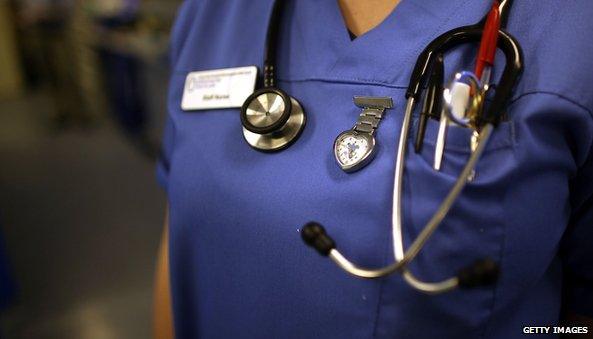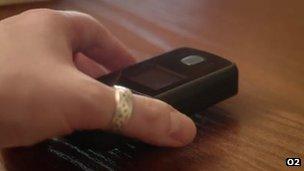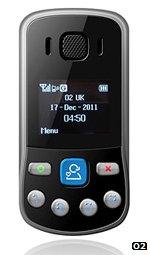Are the benefits of telehealth a myth?
- Published

Telehealth could ease the pressure on health services struggling with ageing populations
It sounds like a no-brainer.
Don't force people with long-term health problems like diabetes or chronic lung disease to trek in to hospital for routine tests and repeat prescriptions - monitor their conditions remotely instead.
That's the promise of "telehealth", where patients monitor their own conditions through home, or even wearable, devices hooked up to the internet.
In theory, telehealth can cut the cost of care while at the same time improving its quality (for example, by letting doctors know about crucial changes when they happen, not at the patient's next appointment).
That's a powerful argument for governments and health maintenance organisations grappling with the soaring cost of long-term care throughout the developed world.
In practice, however, proving telehealth's benefits is tricky.
The UK's National Health Service (NHS), which is hoping to slash the cost of caring for an ageing population, has tried to settle the question by backing the world's largest trial of telecare.
The Whole System Demonstrator trial followed the progress of 1,500 people with three long-term conditions in three different parts of England.
Preliminary results were excellent - the first "headline" results published last year seemed to show that patients using telehealth were 20% less likely to be admitted to hospital and 45% less likely to die than their counterparts in the control group.
Not surprisingly, the government embraced the new way of working.
The Department of Health said telehealth was the answer to the "confused, disjointed, fragmented mess" of today's health and social care system and estimated that the widespread use of telehealth could save the NHS up to £1.2bn over five years.
'Unfounded'
However, the latest detailed findings from the Whole System study paint a more complex picture. A study measuring the quality of life of people using telecare, reported in the British Medical Journal, external, finds that the technology had no measurable effect on feelings of well being.
"The findings suggest that claims for potentially salutary or deleterious effects of telehealth are unfounded for most patients.
"Telehealth should not be introduced with the aim of improving quality of life or psychological outcomes."

O2's Help at Hand device connects wirelessly to a mobile control centre
The researchers, led by Prof Stanton Newton of the School of Health Sciences, City University, London, noted that their conclusions "differ markedly" from those of most previous studies "which are typically interpreted as showing benefits despite presenting equivocal evidence".
In other words, most studies of telehealth are designed by enthusiasts who are likely to draw positive conclusions even when the evidence may not be there to back it up.
This suggests that past studies of telehealth, usually of small pilot projects, should perhaps be treated with scepticism.
However this is not deterring the IT industry, which is ramping up a new generation of consumer devices to enable people to monitor their health - and relay data to their carers and relatives.
The new buzzword is m-health, for devices that use mobile technology.
Earlier this month, O2 - owned by Telefonica - launched Help at Hand, a device aimed at elderly people living in their own homes.
The set-up comprises a special handset with a fall detector, GPS tracking, designated "safe zones" and a one-touch button that links to a 24/7 support centre that can contact loved ones, carers, or the emergency services if help is needed.
O2 is also set to launch another initiative, called Health at Home, which is able to monitor a patient's vital signs.
O2's rival Vodafone is also interested in m-health, where an internet-enabled device such as a smartphone will connect wirelessly to wearable, portable, or embeddable sensors to track or measure a patient's health or movements.
However, a study it published earlier this year, "Evaluating m-health adoption barriers: privacy and regulation", suggests that the technology may have moved ahead of real-life medical practice.
A big challenge is confidentiality - health data collected by people going about their daily lives is inherently less private than data collected in a one-to-one conversation with a clinician.
Vodafone's report also points to regulatory challenges thrown up by m-health applications, which straddle the boundary between medical and telecommunications devices.
Regulators cannot even agree on definitions - for example where a freely sold health and fitness app becomes a medical device, and subject to regulation.
Unstoppable momentum
Undeterred by these questions - and an unhappy track record computerising healthcare - the UK's NHS seems set on a technology-led future.
Telehealth is a big part of the NHS in England's "power of information" strategy, which will also give patients access to their health records on the world wide web.
Jeremy Hunt, the Health Secretary, says that information and technology will help people manage their health independently and give people with long-term conditions control over their own care.

The O2 device can detect if the user has fallen over
His target is for three million people to benefit from telehealth by 2017. This makes England the leading centre for telehealth outside the US.
Announcing the scheme last year, Mr Hunt said: "People with long-term conditions see doctors and nurses more than most of us - £7 out of every £10 spent on the health budget go towards supporting them.
"I want to free people with long-term conditions from the constant merry-go-round of doctors' surgeries and hospitals.
"Technology can help people manage their condition at home, free up a lot of time and save the NHS money.
"In a world where technology increasingly helps us manage our social and professional lives, it seems logical that it should also help people manage their health."
With the government and the IT industry behind it, the momentum towards telehealth seems unstoppable - whatever the complexities of measuring its benefits.
The good news - so far - from the Whole System trial is that telehealth does not seem to do any harm. But whether that finding can justify the claims made for telehealth is another matter.